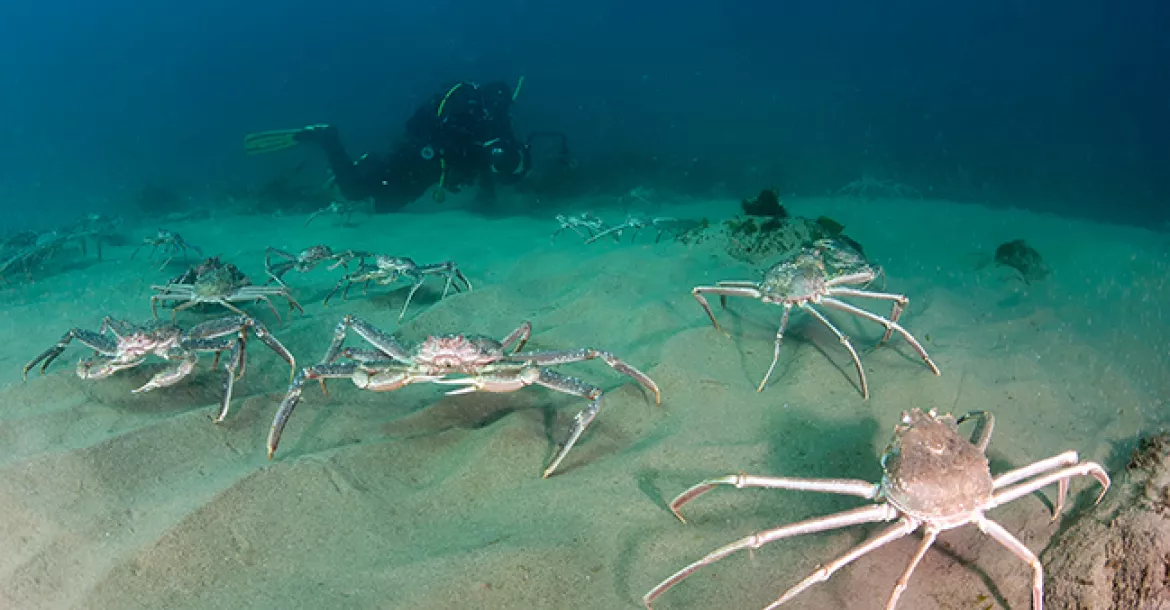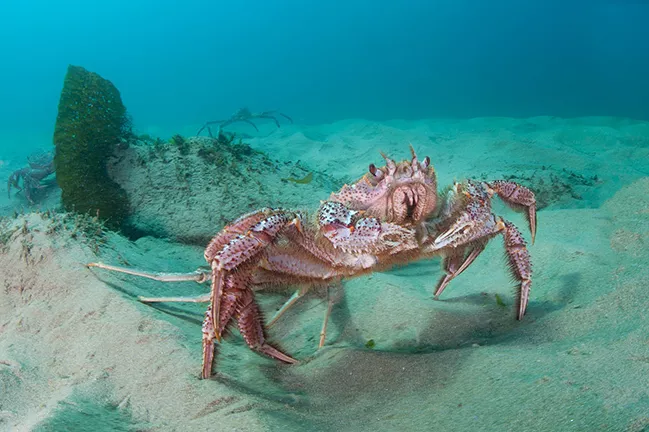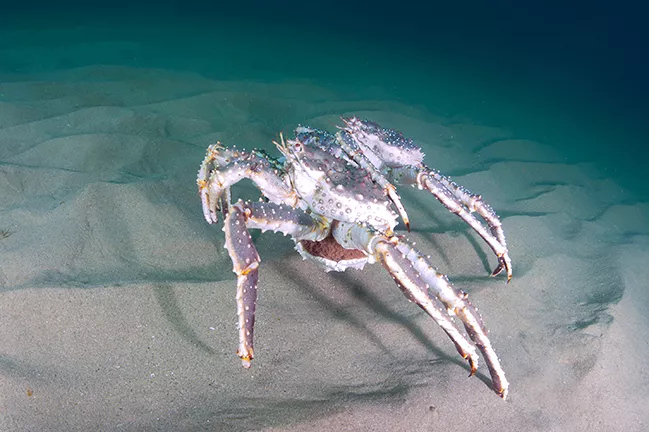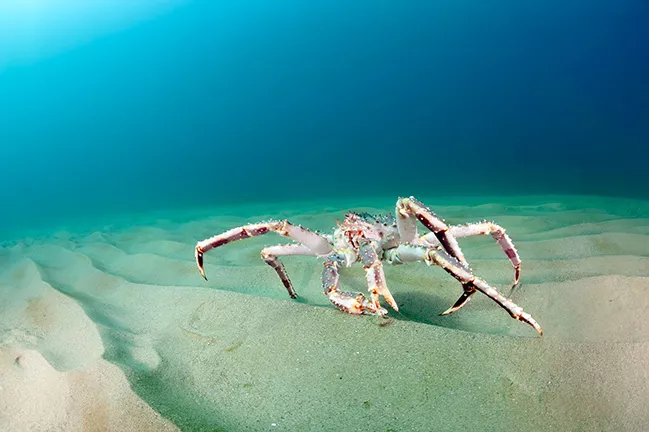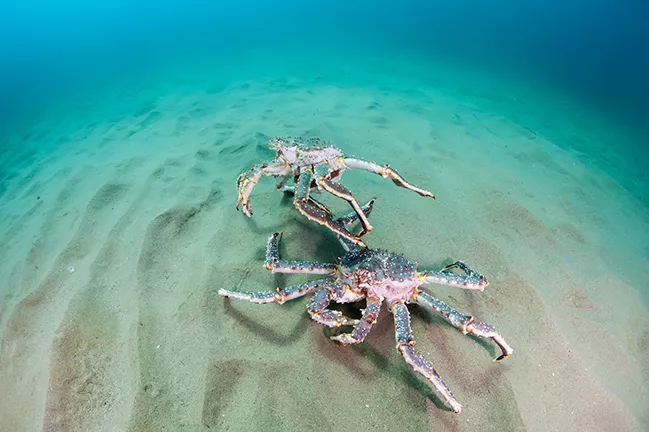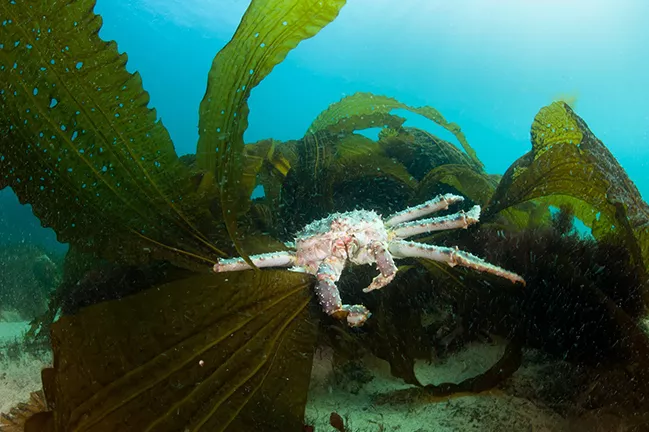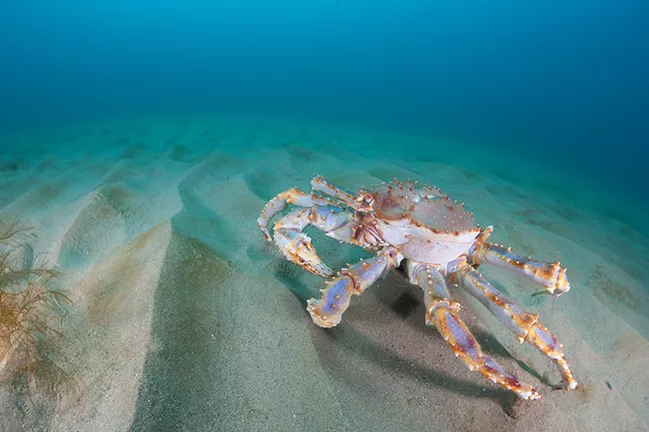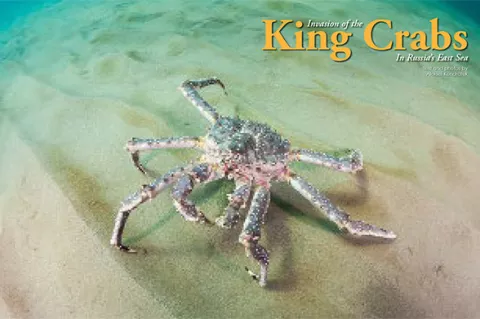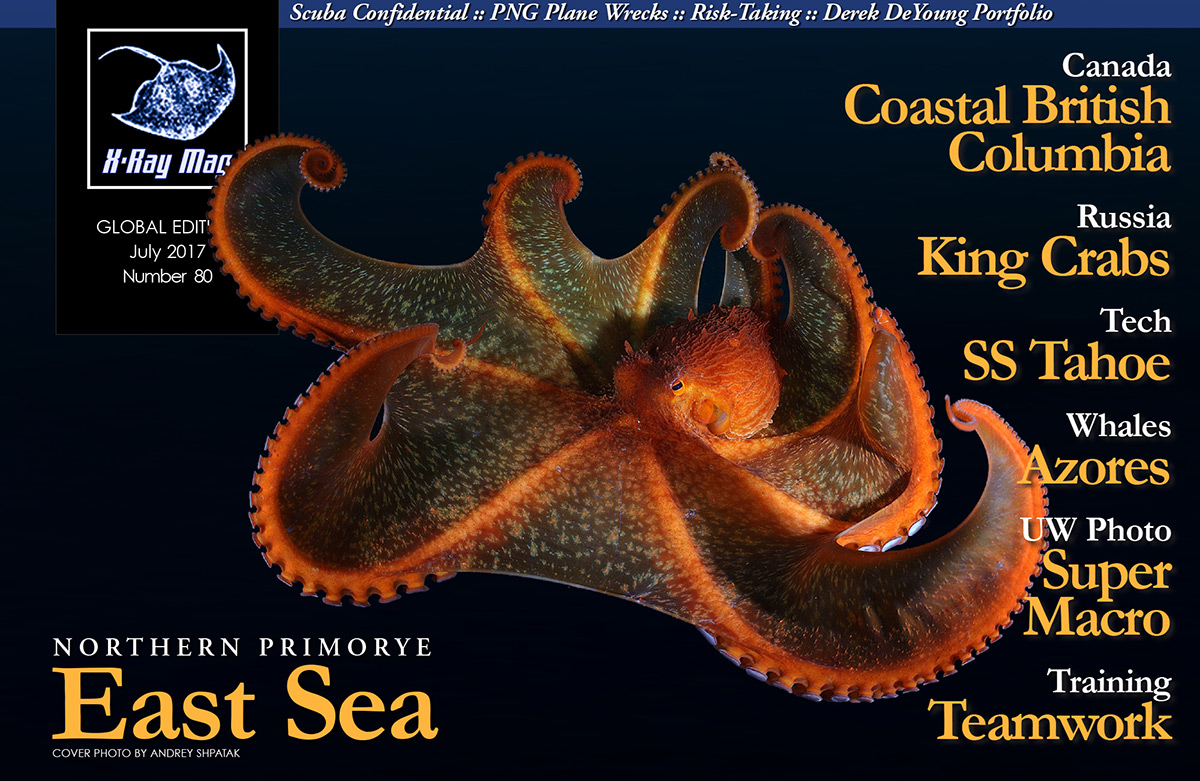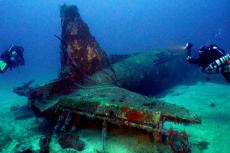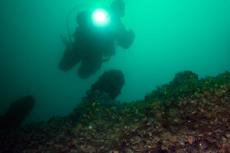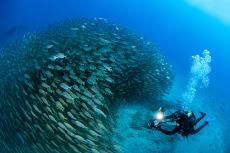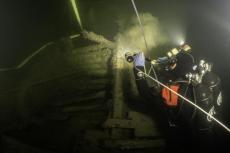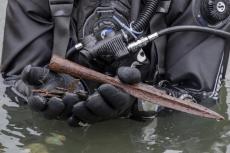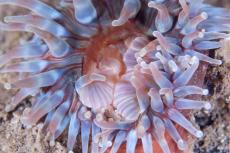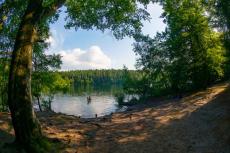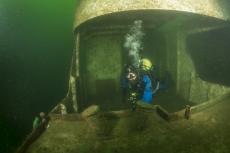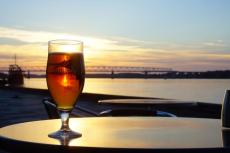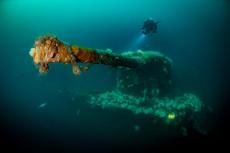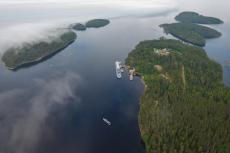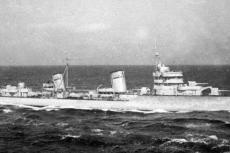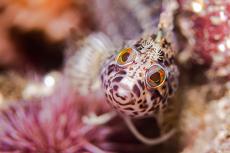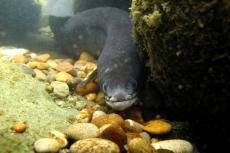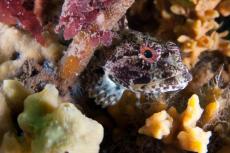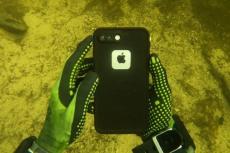In many science fiction movies today—those with alien spaceships—the aliens look very similar to some of the underwater inhabitants of our own planet. Indeed, there is no need to invent some mythical creature to stir up the imagination of the viewer; it is enough just to show an image of a jellyfish, an octopus or a giant crab. And this story is all about the king crabs. There is no need to make deep dives, requiring special training and techniques, to see these aliens underwater. All you need is a little luck and to be in the right place at the right time.
Contributed by
Factfile
Aleksei Kondratuk is an underwater photographer and naturalist born and raised in Vladivostok, on the shores of the East Sea, in the Russian Far East.
After specializing in economics and mathematics, he became a divemaster and began photographing the underwater world.
For more information, visit: uwvision.com.
Over the years, my dive buddy, the local dive operator, and I have searched for king crabs many times. But on one particular occasion, we experienced a successful expedition and encounters we just did not expect.
The Paralithodes camtchaticus is known by different names around the world. The most common are the king crab, Kamchatka crab and giant crab. The last name is an accurate description, as the Kamchatka crab is the largest crab in the ocean. The leg span of an adult crab can reach 150 centimeters, and it can weigh up to 8kg (about 17.5 lbs). The king crab is actually more closely related to hermit crabs and belongs to the anthropod family, Lithodidae—it only looks like a crab. It is called a crab simply because it looks very similar to a crab.
Getting there
Our trip from Vladivostok to the northern part of the province of Primorye in Russia took about 4.5 hours. We covered the long 420km journey by car. Most of the road was unpaved and led through several high mountain passes. At the end of the drive, we reached the village of Valentine, with its eponymous picturesque bay. Here, the steep cliffs, densely covered with pines, met the waters of the East Sea (Sea of Japan). The bay of Valentine is open and has direct access to the sea. Fauna of the northern part of Primorye is very different from the fauna in the southern part. The bay is not covered by ice in wintertime, which allows you to dive all year round.
Migration
The Kamchatka crab regularly migrates. The average speed of its movement is about 1.8km per hour (1mph). But the crab usually moves along the seabed in zigzags, which is why the distance traveled in a day is not more than 10km. Besides, individual creatures move in different directions, so the speed of movement of the entire shoal is only 3-4km per day.
Every year, fishers place their crab pots—the large steel cages used for crab fishing—along the same route within the crabs' migration area. The size of the whole area is about 200km². The crabs spend wintertime very far from the shore, at depths of up to 200-300m. In the spring, they swim up from the depths to shallow water.
So why do the crabs make annual migrations? Their departure to the depths is due to the lower water temperatures in shallow waters and ice formation. Crabs come back to molt and lay eggs—or caviar as foodies would call it—but we will talk about that later.
Diving
We loaded our dive equipment and cameras into the boat, and headed to Cape Orlova. The midday sun hung high, and it was possible to view the sea bottom through the clear waters (which is a very rare sight in this region). Finally, we got to the dive site and decided to start our search for king crab at a depth of 15m. When we reached 35m, we would head back.
When I reached the seabed, my regulator also dropped out of my mouth in surprise! I saw a tropical seascape with clear blue water and white sand. Visibility was about 20m. My brain refused to combine this picture with the sensations of my body. The water was shockingly cold. According to my dive computer, the temperature of the water was -1°C (34°F).
After a moment, my dive buddy and I noticed the first pair of king crabs. These “kings of the sea bottom” met us with caution, exposing their claws in front of them. Near the first pair, we saw another one, and then a few more. After 15 minutes, I stopped counting. They were everywhere: moving slowly along the seabed, hiding in thickets of kelp, clambering over rocks, displaying their claws in defensive postures in the light of our dive lamps.
How crabs feed
Did you know that king crabs find food by touch? Some scientists conducted a small experiment that yielded interesting results. In the experiment, food was immersed in a large aquarium with king crabs. It become clear that the king crabs felt their prey by moving their antenna. King crabs cannot determine their direction by smell, so they began to move, touching the bottom with the ends of their claws.
The king crabs lowered their claws, and performed cutting movements. These movements were very energetic. They moved along the bottom of the aquarium in complex loops. They then began to feel the bottom with their claws more often as they got closer to the food. But even when they were several centimeters away from the food, some individuals turned and continued searching in the opposite direction. The conclusion of this experiment is that king crabs can only find prey through touch, and the sense of smell and sight are of limited assistance to them.
Another interesting fact is that each crab claw carries a separate function. The left claw grinds small prey, and the right one serves to crush shells of mollusks and skeletons of sea urchins. Small prey is ripped out of shells with the king crab’s claws, and ground and grinded with its feet and jaws. King crabs easily eat sea floor polychaetes (segmented worms), mollusks, echinoderms and other benthic animals.
First impressions
The king crabs moved slowly along the sandy seabed like tanks, while my buddy and I "flew" over them like heavy aircraft reconnoitering their movements. An hour later, we finished our dive and got on the boat. My dive buddy had filled a whole 128GB flash card with images. We shared our impressions and discussed the behavior of these aliens from the depths.
After admiring the landscape of the bay, we changed cylinders and went on a second dive after our surface interval. We decided to explore the foot of the cape. I set the course on the compass, and we headed off.
Diving in cold water requires special preparation and equipment. But to foresee everything is simply impossible. At a depth of 15m, both my regulator and octopus went into free flow at the same time. But the problem was quickly resolved when I took a big swig of water into my mouth and rinsed both regulators by blowing a powerful jet of water through them. Continuing the dive, I noticed a large female king crab bearing eggs, a couple of minutes later. What luck!
Female king crabs swim up from the depths to shallow water to procreate. The mating season is in April and May. Males clamp their claws onto the females' claws. Coupling king crabs can remain in this position for up to seven days. The males help the females to molt their shells, and then they attach their "seed" (spermatophores) to the legs of the female. After a while, the female lays her spawn on her abdominal legs. The eggs will hatch during her migration to shallow depths the following year. The period of pregnancy of the female Kamchatka crab is 11.5 months. The males molt separately from the females, hiding among the stones. During molting, the crab changes not only its shell, it also parts with old walls of its stomach, esophagus and intestine. Molting renews all its tendons too.
Second dive
Our second dive was no less interesting. In addition to the king crab, beautiful underwater landscapes with bright sea anemones and dense thickets of kelp, we saw different species of crustaceans. We found a small group of Opilio crab (snow crab) and several individuals of agile hairy crab. These small crabs, densely covered with hairs, can run very quickly. Indeed, one had to be very agile with the camera rig just to get a successful shot!
During the dive, I noticed a king crab with interesting coloration. In contrast to its pale pink color, its claws were pearl-blue. Coming closer, I realized that in front of me was a blue king crab (Paralithodes platypus). And this was luck striking again, because it was my first time seeing this particular species!
In appearance, the blue king crabs are very similar to king crabs. Seen from above, the trunk and limbs are red-brown with blue, while seen from below, they are yellowish-white in color. On the sides of the body and limbs are yellow-orange spots. The blue king crab is slightly inferior in weight and size to the Kamchatka crab. An adult weighs up to 5kg. Another characteristic difference between the blue king crab and the Kamchatka crab are the rounded spines. Blue crab, like Kamchatka crabs, live around 20 to 25 years and often accompany king crabs during migration. Female blue crabs are very rare guests in shallow waters, as they spawn once every two years.
Fishing history
Both types of king crab are fished because their meat is considered a delicacy and in demand all over the world. Far East crabs became famous as a delicacy in the early twentieth century. In the Russian Far East, canned crab has been produced since 1908, at the coastal canning plant in Bay Gaidamak. Later, in the ‘60s, canned crab with the strange name, "CHATKA", became known all over the world.
The story goes that when the canned Kamchatka crabs went on sale, export packaging was produced with the bright inscription, "KAMCHATKA". A major contract was signed for the export of the canned crabs, but the exporters designed and printed can labels with a larger diameter than required by the contract. The price of correcting this error could have cost millions. So, in order not to alter the label, the "erroneous" labels with the word "KAMCHATKA" were glued onto the smaller diameter cans. The first syllable simply did not fit and was cut off, so just the letters "CHATKA" remained.
Here’s a well-known fact from the annals of history of crab fishery: In 1929, 22 Japanese ships came to the shores of Kamchatka. Along the way, they picked up 420,000 crab pots (or traps)—six times more than Soviet ships. In 1929, about 87 million specimens were caught. After that, there was a gradual decline in population. In order to prevent such cases from happening again, people decided to regulate crab catching activities. Today, there are a lot of restrictions on crab fishing.
Where to find king crab
So where can the “king of the sea bottom” be found? The habitat of the Kamchatka crab is large enough: the northern regions of the Far Eastern seas, including Kamchatka, the Shantarsky Islands, Bristol Bay, the Okhotsk and Bering Seas, the coast of Sakhalin, the Kurile Islands, and the northern part of the Sea of Japan (including Peter the Great Bay and the coast of Hokkaido). In addition to the Far Eastern seas, the Kamchatka crab is also found in the Bering Sea.
In the 60s, the Kamchatka crab was transported from the Sea of Okhotsk to the Barents region. For over 30 years, the crabs did not show themselves; people determined that the experiment was unsuccessful. But after these long years, the crab in the Barents Sea formed a new self-reproducing population. After a while, environmentalists got bad news. Such a rapidly growing crab population would simply destroy the bottom fauna of the sea. The simplest solution to this problem was to allow the extraction of crab in the Barents Sea.
Afterthoughts
My story as well as my dive was coming to an end. Dive time: 59 minutes, with 50 bars left in the tank. I was at my safety stop, watching the movements of kelp in the sun. I reminisced over the episodes of the dive, blinking past like photo frames in my memory, one by one. I felt like I was on another planet: a mysterious planet full of extraordinary creatures—Planet Ocean. ◼︎
Published in
-
X-Ray Mag #80
- Läs mer om X-Ray Mag #80
- Log in to post comments

